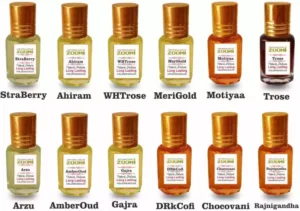Attar (Ittar)
 Attar (also known as Ittar) is a traditional form of natural perfume that has been used for centuries in various cultures, particularly in the Middle East, South Asia, and parts of North Africa. Derived from the Arabic word “ittir,” meaning “to pound” or “to grind,” attar is a highly concentrated perfume oil extracted from botanical sources. Its rich history, meticulous production process, and unique fragrances make it a cherished and sought-after olfactory experience.
Attar (also known as Ittar) is a traditional form of natural perfume that has been used for centuries in various cultures, particularly in the Middle East, South Asia, and parts of North Africa. Derived from the Arabic word “ittir,” meaning “to pound” or “to grind,” attar is a highly concentrated perfume oil extracted from botanical sources. Its rich history, meticulous production process, and unique fragrances make it a cherished and sought-after olfactory experience.
Historical Significance:
The history dates back thousands of years, with origins in ancient Mesopotamia and Egypt. It has been an integral part of cultural and religious practices in regions where it is produced. It played a significant role in ancient trade routes, with traders carrying precious vials of this fragrant oil across continents.
Production Process of Attar:
The creation of ittar involves a labor-intensive and intricate extraction process, emphasizing quality over quantity. Here are the key steps involved:
- Selection of Raw Materials: Ittar is primarily made from natural botanical sources. Common plants used include roses, sandalwood, jasmine, oud (agarwood), and various herbs and spices. The quality and origin of these botanicals greatly influence the final fragrance.
- Distillation: The chosen botanicals are subjected to steam or hydro-distillation. This process involves passing steam through the plant material to release its aromatic compounds. The resulting vapor is then condensed to form a mixture of essential oil and water.
- Separation: The essential oil, being lighter than water, floats on the surface and can be carefully collected. This is the precious attar oil.
- Aging and Maturation: Ittar is often aged for a period ranging from several weeks to several years. This allows the fragrance to develop and mature, enhancing its depth and complexity.
- Blending (Optional): Depending on the desired fragrance, different attars may be blended together to create unique and distinctive scents.
- Bottling and Packaging: The finished ittar is then carefully bottled in small, airtight containers. Traditionally, ittar is presented in beautifully crafted glass vials, often adorned with intricate designs or calligraphy.
Common Botanical Sources:

- Rose Attar (Gulab Ittar): One of the most revered and widely used attars, rose attar is obtained from the petals of various species of roses, with Damask roses being a popular choice. It has a rich, sweet, and deeply floral aroma.
- Sandalwood Attar (Chandan Ittar): Extracted from the heartwood of sandalwood trees, this attar has a warm, woody, and creamy scent. It is known for its calming and grounding properties.
- Jasmine Attar (Chameli Ittar): Jasmine flowers are used to create this attar, resulting in a rich, sweet, and intensely floral fragrance. It is often associated with sensuality and romance.
- Oud Attar (Agarwood Ittar): Derived from the resinous heartwood of agarwood trees, oud attar is highly prized for its complex, earthy, and woody aroma. It is one of the most expensive and sought-after attars.
- Musk Attar: Traditionally sourced from the glandular secretions of musk deer, modern production often uses synthetic alternatives. Musk attar has a warm, animalic, and sensuous scent.
- Kewra Attar: Obtained from the flowers of the kewra plant (Pandanus odoratissimus), this attar has a sweet, floral, and slightly spicy fragrance. It is commonly used in perfumery and culinary applications.
Cultural and Ritual Significance :
 Attar holds great cultural and spiritual significance in various regions:
Attar holds great cultural and spiritual significance in various regions:
- Islamic Traditions: It plays a prominent role in Islamic traditions and rituals. It is often used in religious ceremonies, special occasions, and as a personal fragrance during prayer.
- Ayurvedic and Traditional Medicine: In Ayurveda, the traditional medicine system of India, it is valued for its therapeutic properties. It is believed to have various healing effects on the body and mind.
- Weddings and Celebrations: It is a customary gift in many cultures during weddings and other celebrations. It symbolizes luxury, purity, and well-being.
- Meditation and Yoga: The use of attar in meditation and yoga practices is believed to enhance focus, relaxation, and spiritual awareness. Certain attars, like sandalwood and frankincense, are particularly favored for these purposes.
- Personal Grooming and Perfumery: It is used by individuals as a natural alternative to synthetic perfumes. It is prized for its unique, long-lasting fragrances that react uniquely with the wearer’s skin.
Modern Trends and Commercialization:
In recent years, there has been a resurgence of interest in natural and artisanal products, including ittar. Artisans and perfumers worldwide are rediscovering and reinterpreting traditional Ittar-making techniques. This revival aligns with the growing demand for sustainable, natural, and ethically sourced fragrance options.
Additionally, many fragrance houses and perfumers are incorporating ittar-inspired notes into their compositions, adding depth and complexity to contemporary perfumes.
Conclusion:
Ittar is a testament to the artistry and craftsmanship that goes into creating unique and natural fragrances. Its rich history, meticulous production process, and diverse range of botanical sources contribute to its enduring allure. Whether used for religious and cultural rituals, personal grooming, or as a cherished gift, attar continues to hold a special place in the world of perfumery and personal fragrance. It embodies a connection to nature, tradition, and the olfactory senses, offering a sensorial journey that transcends time and borders.
